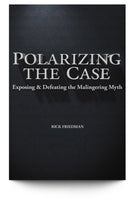Polarizing the Case from Trial Guides on Vimeo.
Polarizing the Case is the #3 book of all time at Trial Guides, just behind Rules of the Road and David Ball on Damages. It has been called "the bible for anyone trying cases in today's climate" by legendary trial lawyer Brian Panish.
With Rules of the Road™, Rick Friedman (with co-author Patrick Malone) changed the way tens of thousands of plaintiff's lawyers try their cases. In the process, he established himself as one of the nation's leading tacticians in the battle for civil justice. With Polarizing the Case, Friedman teaches us not to fear allegations or insinuations that our client is malingering or exaggerating injuries.
Polarizing the Case is split into two parts. Part one discusses the Polarizing method. This method is critical in any type of personal injury case where the defense will infer that your client is either faking or exaggerating their injuries. Instead of saying the client is lying, the defense witnesses will say the client is "malingering" (a conscious decision to fake or exaggerate symptoms) or that the client has either "somatoform disorder" or "somatization disorder" (both unconscious forms of faking and exaggerating symptoms). These allegations are almost always an intentional decision by the defense witness to mislead jurors when the injured person has well substantiated injuries. Often the defense witness will use junk science such as the Fake Bad Scale to represent to the jury that they can confirm that the client is lying.
Rick Friedman defines the problem, and offers a solution. He takes you through screening and preparing the case, writing the complaint, discovery, what to look for in the IME report, and deposing the defendant and the defense doctor. He discusses the choice between revealing the defense expert deception in deposition versus trial. From there he turns to trial preparation, motions in limine, voir dire, opening, your case in chief, cross examination of the defense doctor, and closing statement. In each phase of pre-litigation case development and within litigation and trial, Rick discusses how to fight defense lawyers and defense lawyers who claim your client is malingering, or has somatoform disorder or somatization disorder. He discusses how to clearly demonstrate to the jury that the defense will count your client's honest answers on the MMPI personality test against them, and how they will misrepresent they have scientific substantiation that your client is a liar.
In the second part of Polarizing the Case, you get "directors cut" insights of the Polarizing method in one of Rick Friedman's trials. He walks you through the trial transcript discussing how and why he made the choices he did to achieve a great outcome in a conservative jurisdiction. He provides you an introduction to the case, the husband's testimony, the plaintiff's doctor's testimony, a friend's testimony, the client's testimony, the cross examination of the defense doctor, and then closing statement.
Polarizing the Case may not be for the faint of heart, but it is very effective. Tens of thousands of lawyers have purchased Polarizing the Case, many of whom have created careers filled with stunning verdicts using this method. When done correctly, unveiling the defense doctor deception of the jury, the results can be explosive. Don't miss this important book.
- Introduction
- Part I: Description
- Defining the Problem
- A Solution
- Screening and Preparing the Case
- The Complaint
- Written Discovery
- Deposing the Defendant
- The IME Report
- Deposing the Treating Doctor
- Depsoing the IME Doctor
- Calling the Expert's Bluff
- Motions in Limine
- Tone at Trial
- Voir Dire
- Opening
- Case in Chief
- Cross Examination of the IME Doctor
- Closing
- The Psychologic of Polarizing
- A Chapter for Defense Counsel
- Polarizing in Other Types of Cases
- Part II: Illustration
- The Lace Case
- Opening Statements
- The Husband's Testimony
- The Plaintiff's Neuropsychologist's Testimony
- The Friend's Testimony
- The Client's Testimony
- The IME Doctor's Testimony
- Closing Arguments
- Appendix A
- Appendix B














 View Excerpt
View Excerpt